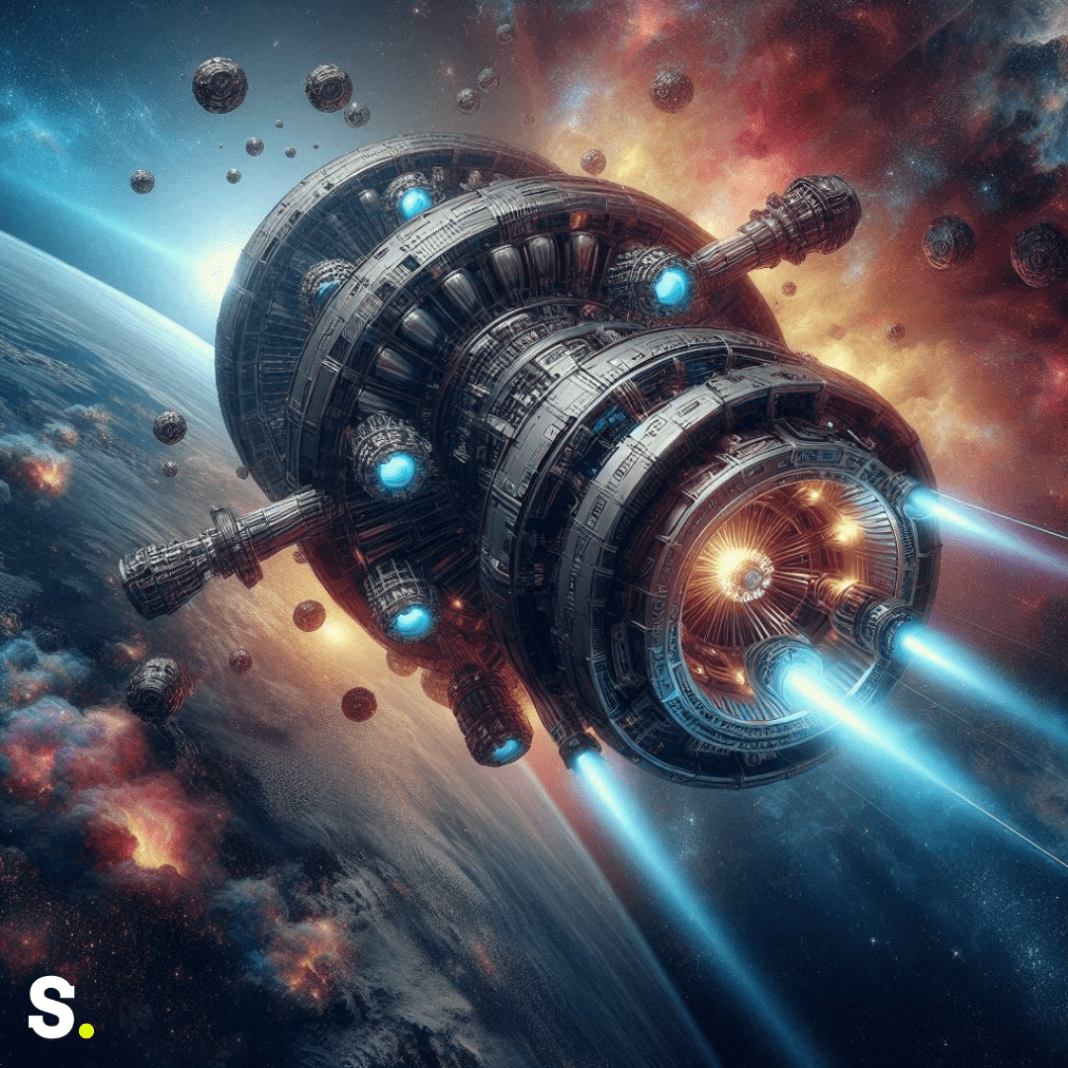The ceaseless quest for technological progress on the part of humanity has moved us from the manipulation of fire to the creation of the wheel and, more recently, space propulsion systems that allow us to explore space. In the field of space exploration, aerospace propulsion technologies play a crucial role in defining our trip distance, speed, and cargo capacity. This article provides a thorough analysis of propulsion’s current situation, the difficulties it faces, and upcoming advancements in this rapidly changing subject.
Understanding Space Propulsion
A specialized area of aeronautical engineering called “space propulsion” is concerned with the techniques and tools used to move satellites and spacecraft through space. The main goal of propulsion systems is to generate enough thrust to counteract gravitational forces and achieve controlled, directed motion. There are various types of propulsion systems, each with unique attributes suitable for different mission requirements.
Propulsion vs. Thrust: Clarifying Concepts
In the context of aerospace, particularly space propulsion, the terms “propulsion” and “thrust” are often used interchangeably, but they have different functions within the dynamics of moving vehicles. The entire system and processes required to move an object through space or the air are referred to as propulsion. Different parts such as engines, power sources, and force-generating techniques can be a part of this system. This frequently refers to systems for delivering fuel as well as thrust-generating devices in space propulsion. Contrarily, thrust is the force generated by a propulsion system that propels an item in a predetermined direction—typically forward. Certain parts of a propulsion system produce thrust, which opposes opposing forces like drag and gravity to facilitate mobility.
Traditional Methods: An Overview
Since there is an equal and opposite reaction to every action, Newton’s Third Law of Motion has been the mainstay of traditional propulsion techniques. The methods commonly used are chemical space propulsion, electric space propulsion, nuclear propulsion, and cold gas space propulsion. The most common type of space propulsion is chemical, which generates high-velocity exhaust gasses through combustion reactions between an oxidant and a fuel. Solid, bipropellant, and monopropellant rockets are all included in this. Chemical propulsion offers high thrust and proven technology but requires heavy fuel loads and has limited efficiency. Electric or ion propulsion systems, such as Hall Effect Thrusters and ion drives, offer significantly higher efficiency than their chemical counterparts but provide low thrust and depend on electrical power. Nuclear propulsion uses nuclear reactions to heat a propellant, presenting a future alternative to chemical methods with high specific impulse and potential for high thrust, but faces technological, safety, ethical, and political challenges. Pressurized inert gases are used for precision control jobs in cold gas propulsion systems, not as the main source of propulsion. They are simple and reliable but have low efficiency.
Major Challenges in Space Propulsion
Space propulsion faces multi-dimensional challenges rooted in technological and theoretical constraints. For a thorough grasp of propulsion difficulties, a multidisciplinary approach incorporating economics, geopolitics, engineering, and physics is necessary. These are a few of the main challenges:
Energy Efficiency in Space Propulsion
Calculating a propulsion engine’s particular impulse—that is, the change in momentum per unit weight of propellant—is a common step in determining the engine’s efficiency. Chemical rockets usually have low specific impulse and need a lot of fuel to produce a given thrust. Due to energy density restrictions, conventional chemical fuels like liquid oxygen and hydrogen require larger fuel tanks. As a result, mass increases and propulsion efficiency decreases.
Scalability and Cost in Space Propulsion
In contrast to the automotive and aviation sectors on Earth, space propulsion is not able to take advantage of economies of scale that could lower the cost of propulsion systems. It takes a lot of money to invest in new propulsion technologies because the research and development process takes years or even decades. This financial challenge is exacerbated by the high cost of launching materials into space, where every kilogram of payload incurs substantial expense.
Technological Constraints in Space Propulsion
Propulsion engines must endure extreme conditions such as high temperatures, pressures, and radiation. Making materials resilient to these circumstances is frequently expensive and difficult. Additionally, shrinking the size of propulsion systems without compromising efficiency poses significant challenges, especially for interplanetary or interstellar missions. Advanced materials and precision engineering are critical to addressing these constraints, but they also drive up costs and development time.
Theoretical Limits in Space Propulsion
Based on the Tsiolkovsky rocket equation, missions beyond our solar system are extremely difficult to accomplish with current propulsion systems since the fuel need increases exponentially with the desired change in velocity. According to the theory of relativity, energy needs explode when velocities approach near-light speeds. This means that propulsion techniques used today, such as chemical or even nuclear, are useless for traveling close to light speed. Overcoming these theoretical limits may require revolutionary breakthroughs in propulsion physics and novel concepts like warp drives or antimatter engines, which are still largely speculative.
Safety and Environmental Concerns in Space Propulsion
Nuclear propulsion, though promising in terms of efficiency, comes with risks such as contamination and waste disposal challenges. Navigational dangers are caused by an increase in potential debris as a result of increased propulsion activity. Ensuring the safe use of nuclear materials in space and mitigating the environmental impact of increased space traffic are critical concerns that must be addressed through stringent regulations and innovative technologies.
Fastest Propulsion Speed
NASA’s Parker Solar Probe, which was launched in 2018, has the fastest propulsion speed ever. In experimental vehicles such as the X-43, conventional propulsion systems such as scramjets have also demonstrated remarkable velocity, attaining Mach 9.6. These high-speed achievements demonstrate the potential of advanced propulsion technologies, but also highlight the challenges of sustaining such speeds over long durations and in the vacuum of space.
Geopolitical Constraints
International regulations may restrict the kind of propulsion technology that can be employed, such as nuclear propulsion systems. Cooperative efforts in propulsion technology development may be hampered by competing interests among nations as they expand into space for orbital slots and landing sites. Diplomatic negotiations and international treaties will play a crucial role in navigating these geopolitical constraints and fostering global cooperation in space exploration.
Emerging Technologies in Space Propulsion
With its dual thrust operation modes, the Variable Specific Impulse Magnetoplasma Rocket (VASIMR) expands the capabilities of space propulsion. Nuclear propulsion systems have shown potential for upcoming space missions, as seen by recent expenditures. Since antimatter propulsion offers the highest specific impulses imaginable, it has the potential to revolutionize propulsion, albeit being mainly theoretical. These emerging technologies represent the frontier of space propulsion research, with the potential to overcome many of the current limitations and enable more ambitious space missions.
Enabling Tomorrow’s Exploration
Opening the solar system for human exploration will require the maturation of nonchemical space propulsion, such as nuclear thermal propulsion, solar sails, and electric propulsion. NASA’s current design reference for a human mission to Mars has options for nuclear thermal propulsion and electric propulsion for reaching the destination. These sophisticated propulsion ideas can also enhance robotic test missions in the years preceding a human planetary trip. Using a solar sail, Marshall’s Near-Earth Asteroid Scout (NEA Scout) mission will send a CubeSat out to examine an asteroid as part of SLS’s planned Exploration Mission 1 test flight. In addition to the sail and deployment mechanism, the mission will also evaluate new attitude determination and control systems (ADCS) needed for solar sail missions.
In the area of electric propulsion, Marshall’s iSat project is collaborating with the University of Alabama in Huntsville and the Glenn Research Center to assess an iodine-fueled Hall thruster and related feed systems for use in small spacecraft. The technologies developed for this flight demonstration will have applications both in operationally responsive space near Earth and low-cost interplanetary exploration in the future. Marshall runs two facilities for testing and development on nuclear thermal propulsion. The bigger one, the Nuclear Thermal Rocket Element Environmental Simulator (NTREES), is used to evaluate different materials for nuclear thermal rocket fuel elements in a realistic, non-nuclear manner. The NTREES facility simulates space-based nuclear propulsion systems and provides baseline data essential for risk reduction in future propulsion development by testing fuel elements and materials in hot flowing hydrogen at pressures up to 1,000 psi and temperatures of about 5,000 F. Depleted uranium testing is permitted using the Compact Fuel Element Environmental Test (CFEET), which does high-temperature testing but not high-pressure testing. Marshall offers a special capacity to carry out the full research process internally by merging our fundamental and practical nuclear and materials research and skills.
In the area of advanced fusion research, Marshall is a partner with the University of Alabama at Huntsville’s fusion pulse power research project, along with Boeing and the STMD. A donated DOD device, originally intended for studying the consequences of nuclear weapons, is employed in this investigation. About 500,000 joules of energy are produced every pulse by the almost 50-ton complete assembly. Research on electric propulsion encompasses special competencies in nuclear fusion propulsion and high-power pulse-electric propulsion systems. Marshall runs a low-thrust vacuum chamber for research on electric propulsion and is also capable of being utilized for chemical propulsion. Using leftover propellant from an upper stage that had been burned, a recent test was able to replicate a 6-pound thruster. To manage satellite attitude or de-orbit wasted stages, the industrial partner may therefore want to include such thrusters. The chamber has the capability to evaluate further innovative propulsion ideas, like hybrid solid-electric systems.
In addition, Marshall oversaw four of NASA’s tethered satellite experiments: the Small Expendable Deployer Systems (SEDS I and II) and the Shuttle Tethered Satellite System (TSS-1 and -1R). Tethers have great potential for raising satellites or deorbiting them at the end of operations by operating as an electric motor with or against Earth’s magnetic field. The Center continues to investigate advanced uses for satellites orbiting beyond 70˚ inclination for Earth observation, weather, telecommunications, remote sensing, and planetary exploration. The Center has been involved in solar sail research from concept to flight. Marshall assisted in testing the stiffness, strength, and behavior of two competing prototypes in 2004. These tests provided valuable data for the NASA In-Space Propulsion Program.
As we look to the future, the development and refinement of advanced space propulsion technologies will be crucial for extending humanity’s reach into the cosmos. The challenges are formidable, but the potential rewards – from enabling human missions to Mars and beyond to revolutionizing our understanding of the universe – make the pursuit of these technologies are among the most significant and fascinating projects of our day.




